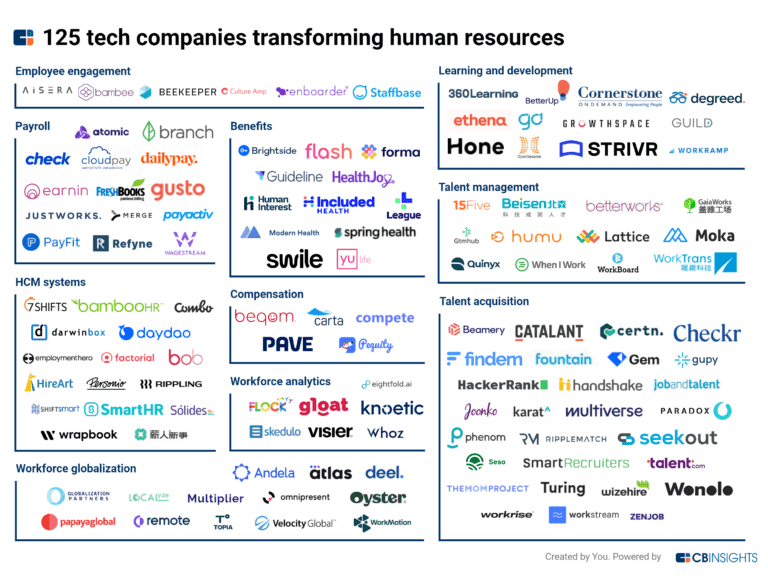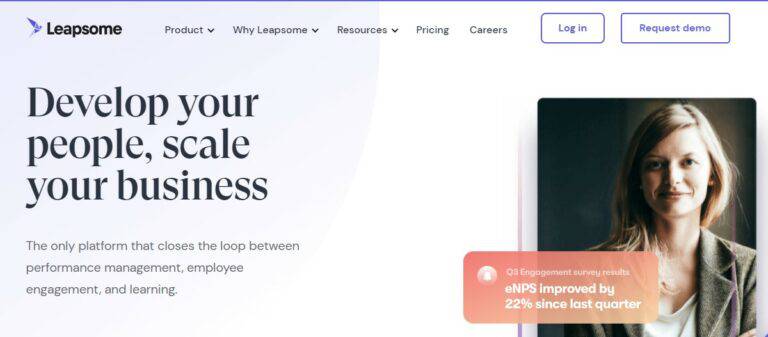
Culture Amp
Founded Year
2010Stage
Series F | AliveTotal Raised
$258.3MValuation
$0000Last Raised
$100M | 3 yrs agoRevenue
$0000Mosaic Score The Mosaic Score is an algorithm that measures the overall financial health and market potential of private companies.
-42 points in the past 30 days
About Culture Amp
Culture Amp is a market-leading employee experience platform focused on transforming organizational culture within various business sectors. The company offers a suite of tools for employee engagement, performance management, and employee development, designed to help organizations build competitive advantages by prioritizing their culture. Culture Amp's solutions are utilized by companies across different industries to manage and improve their workforce experience. It was founded in 2010 and is based in Richmond, Victoria.
Loading...
Culture Amp's Product Videos
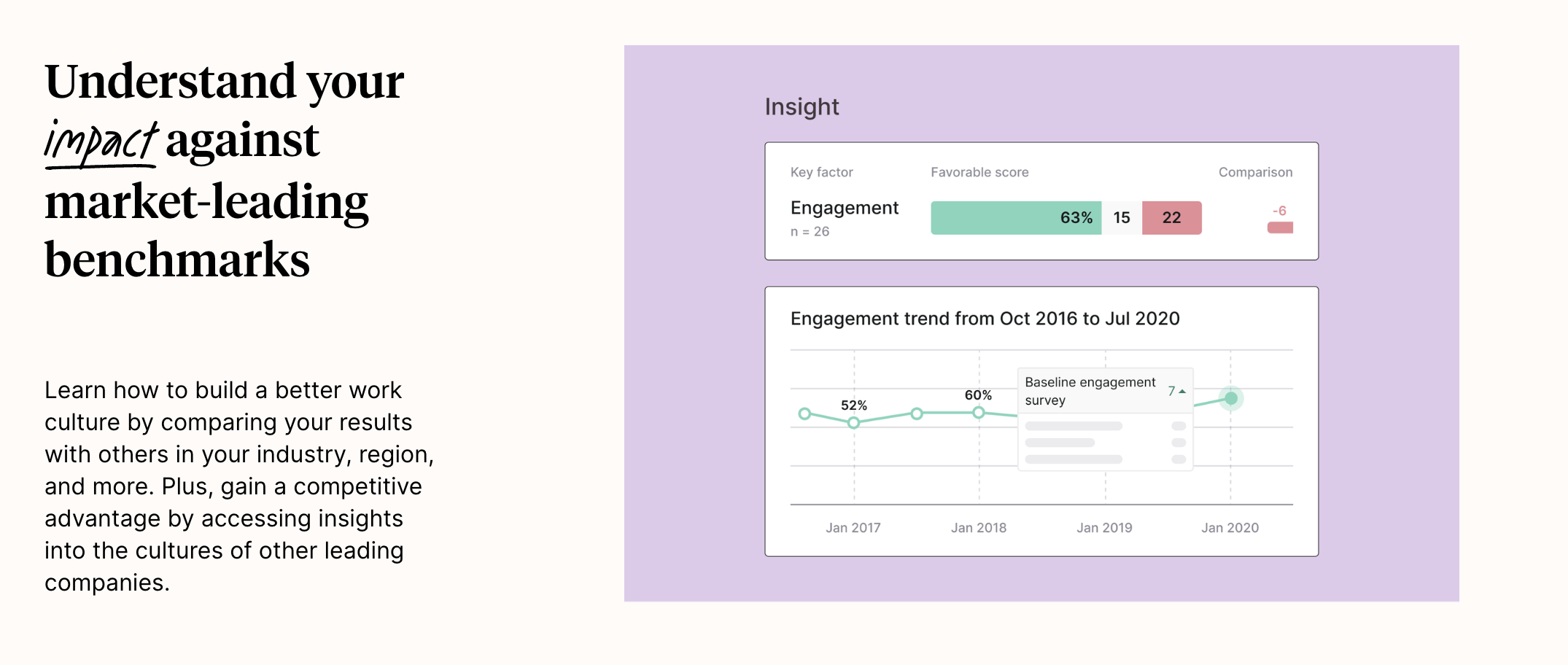
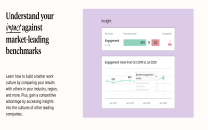
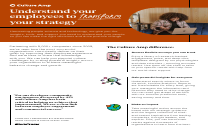
ESPs containing Culture Amp
The ESP matrix leverages data and analyst insight to identify and rank leading companies in a given technology landscape.
The employee performance management market helps companies effectively manage their talent to achieve business objectives. This specifically focuses on software platforms that identify and help address behavioral gaps within teams, track OKRs and goal progress, and reinforce continuous performance management techniques. These solutions aim to increase productivity, improve outcomes, cultivate tale…
Culture Amp named as Outperformer among 15 other companies, including Lattice, Humu, and Quantive.
Culture Amp's Products & Differentiators
Engage
Ask the right questions and get the visibility you need to make strategic decisions With Engage, you can: Equip leaders to engage and retain their people with powerful analytics and effective action plans. Prioritise the right programs with accurate data across the employee experience, and demonstrate improvements against robust benchmarks. Save time, drive better outcomes, and do more with less - HRIS Integrations make data management easy, and flow of work integrations increase participation and adoption.
Loading...
Research containing Culture Amp
Get data-driven expert analysis from the CB Insights Intelligence Unit.
CB Insights Intelligence Analysts have mentioned Culture Amp in 3 CB Insights research briefs, most recently on Feb 9, 2023.
Expert Collections containing Culture Amp
Expert Collections are analyst-curated lists that highlight the companies you need to know in the most important technology spaces.
Culture Amp is included in 4 Expert Collections, including HR Tech.
HR Tech
5,910 items
The HR tech collection includes software vendors that enable companies to develop, hire, manage, and pay their workforces. Focus areas include benefits, compensation, engagement, EORs & PEOs, HRIS & HRMS, learning & development, payroll, talent acquisition, and talent management.
Unicorns- Billion Dollar Startups
1,249 items
Future Unicorns 2019
50 items
Tech IPO Pipeline
257 items
The tech companies we think could hit the public markets next, according to CB Insights data.
Latest Culture Amp News
Sep 26, 2024
How to Effectively Highlight Your SaaS Product’s Key Features Online Marketing your SaaS product can feel like a challenge, especially when you’re trying to make your key features stand out online. It’s easy to fall into the trap of over-explaining or using technical terms that don’t really land with your audience. Features can easily get lost in jargon, or worse, you’ll come off sounding just like everyone else. However, it doesn’t have to be that way. In this article, we’re going to cover some straightforward tips for highlighting your product’s features in a way that feels natural and easy for your audience to grasp. Read on to learn some simple yet advanced strategies to refine your SaaS product marketing without coming across as pushy or overwhelming. Align Product Features with Niche User Segments When you tailor your messaging to the distinct concerns of different customer groups, you’re showing your audience that your product isn’t just a one-size-fits-all solution but built to solve their specific challenges. You prove that you understand their specific needs. Tap into This Strategy Define your key user segments. Dive deep into their unique challenges and goals. Map your product features to these specific needs. For example, if you’re targeting both small businesses and enterprises, highlight different features for each. Create targeted content for each segment. This could be separate landing pages, blog posts, or even product guides. Use language that speaks directly to each group’s pain points and aspirations. Don’t just list your product features. Show how they solve real problems for each segment. Personalize your demos and trials, too. Set up different paths based on user segments, showcasing the most relevant features first. Example A great example of this tactic is DialMyCalls, a platform that enables mass texting. They’ve created a guide to sending emergency text messages that speaks to various niche audiences. Here, they dive deep into the details of how their service can be used in different emergency scenarios. From natural disasters and infrastructure failures to health crises and cybersecurity threats, they highlight how their service’s features apply to each scenario. This targeted approach makes their product more relatable and valuable to niche users rather than offering a generic solution. It helps potential customers see themselves using the product, making the features more tangible and valuable. This is a smart way to make your product more compelling and, ultimately, more likely to be adopted by those who need it most. Ensure Explainer Videos Prominently Feature Your USPs Explainer videos are a marketing powerhouse, especially when they showcase your unique selling points (USPs). They’re used by 91% of people whenever they’re scoping out a product or service. That makes video the most used format for consuming information about potential purchases. Tap into This Strategy Start with a hook that grabs attention, then dive right into your USPs. Show how your features solve real problems for your audience. Use simple language and visuals that make complex concepts easy to grasp. Remember that your video should tell a story. Introduce a relatable character facing a challenge, then show how your product swoops in to save the day. Highlight your USPs naturally throughout this narrative. End with a clear call-to-action (CTA). What do you want viewers to do next? Make it obvious and easy. Example Rosie , an AI-powered answering service, nails this approach on their homepage. Their video features a simulated phone conversation between a customer and Rosie’s AI bot. It’s a brilliant way to showcase their USPs in action. In this real-world scenario, viewers can see firsthand how the AI handles customer questions, schedules appointments, and manages complex conversations. This way, the video resonates with business owners who struggle with managing high call volumes or providing 24/7 customer service. By focusing on these pain points and showcasing their solution in action, Rosie creates a compelling case for their service that goes beyond mere feature lists. This approach effectively demonstrates how Rosie can streamline operations and expand a business’s capabilities. Express Features As They Benefit the User Camouflaging features as user benefits is a game-changer, especially in early-stage SaaS product marketing. That’s because site visitors don’t care about your fancy tech. They care about what it can do for them. This approach is vital for homepage messaging, where you need to grab attention fast. The key here is to focus on outcomes, not processes. Don’t dive into the nitty-gritty of how your system works. Instead, show visitors what they’ll gain. Keep these messages simple and direct. Think “Save 3 hours a day” rather than “Our AI-powered algorithm optimizes task management.” Tap into This Strategy Start by listing your key features. Then, for each one, ask yourself: “So what?” Keep thinking of questions until you hit a tangible benefit. Use clear, jargon-free language that speaks directly to your user’s needs and desires. Frame benefits in terms of time saved, money earned, or problems solved. The top part of your homepage isn’t the place for technical deep dives. Save those details for later in the sales process when leads are more invested. Example Vidpros, a video editing on-demand service , exemplifies this approach beautifully. Their homepage section, “We Make Video Editing Easy,” is a masterclass in simplicity. Here, they break down their process into straightforward steps like “submit your video” and “request a revision” without getting bogged down in technical details. Vidpros resists the urge to brag about their sophisticated software as well. Instead, they focus on the user experience. They know that at this early stage, potential clients don’t care about complex features. They just want to know if the service can solve their problem. Highlight Product Features on Your Pricing Page The pricing page is often the make-or-break point in the customer journey. Leads that land on it are seriously considering your product. That’s why the pricing page is a great chance to seal the deal by showing visitors exactly what they’re getting for their money. Tap into This Strategy Align your product features with different pricing tiers. But don’t just list them – explain how each feature adds value. Use clear, benefit-focused language that speaks to your customer’s needs. Consider using a comparison table to make it easy for leads to see what’s included in each plan. Don’t overwhelm with too much info. Highlight key features that differentiate each tier and link to more detailed specs for those who want to dig deeper. Use icons or visual cues to make the page scannable. Address common questions or objections right on the pricing page. This could be through FAQs, tooltips, or short explanations next to each feature. Example GetSafe , a medical alert systems provider, nails this approach on their pricing page. They break down features for each plan in a way that’s clear and actionable so leads can easily see what they’ll get with each option. What’s really smart is how GetSafe pairs feature descriptions with images of the product bundles for each plan. This visual approach helps customers understand exactly what they’re getting, which is crucial when selling physical products like medical alert systems. By presenting features this way, GetSafe makes it easy for leads (who might be seniors or their family members) to choose the right plan for their needs. This approach likely boosts conversions by giving customers all the info they need to make a confident decision right there on the pricing page. Use Customer Testimonials Highlighting Specific Feature Use Cases It’s also a great chance to use your existing customers’ voices to highlight specific product features. It’s logical because potential customers trust real users more than your marketing copy. When they see how others are using your features to solve real problems, it makes your product’s benefits tangible and relatable. Tap into This Strategy Start by collecting detailed feedback from your happy customers. Ask them specifically about which features made the biggest impact on their business. Then, craft these stories into concise, punchy testimonials that highlight both the feature and the outcome. Don’t just stick these testimonials on a separate page. Sprinkle them throughout your site, especially near relevant feature descriptions. Use pull quotes to draw attention to key points. If possible, include the customer’s name, company, and photo to add credibility. Consider creating video testimonials, too. They’re more engaging and can convey the enthusiasm that written words sometimes miss. Example Zendesk , a leading customer service platform, applies this method on their homepage. They feature a section with customer testimonials that zero in on the most impactful Zendesk features for each client’s success. By showcasing these real-world use cases, Zendesk shows how these features solve actual business problems. That instantly clicks with potential customers who can see themselves in similar situations. For instance, testimonials can highlight how Zendesk allows companies to collect data on customer interactions or how their workflow capabilities help improve customer satisfaction scores. These specific examples make Zendesk’s features come alive, showing not only what the platform can do but also the real-world impact it can have. Leverage Webinars to Showcase Key Feature Benefits Webinars allow you to dive deep into your product’s capabilities while providing real-time value to your audience. They’re interactive and engaging, and they give potential customers a chance to see your features in action. Tap into This Strategy Then, build webinars around these topics. Keep your webinars educational and value-packed. Use real-world examples and case studies to illustrate how your features solve actual problems. Include a Q&A session to address specific concerns and showcase your product’s flexibility. Consider creating a series of webinars to cover different features or use cases, keeping your audience engaged over time. Avoid using your platform just to demo your product. Frame the webinar as a solution to a common industry challenge. This approach positions you as a thought leader while subtly highlighting your product’s strengths. Remember to follow up after the webinar. Send recordings to attendees and use the engagement data to nurture leads. Culture Amp, an employee experience platform, excels at this strategy. They host tons of webinars focused on hot topics like employee satisfaction, retention, and overall experience. These are all valuable sessions that address real HR challenges. For instance, their “Build a Culture First Performance Process” webinar features an expert discussing how to improve performance management. Throughout the session, they naturally weave in how Culture Amp’s features can help tackle these issues. This approach allows Culture Amp to demonstrate their expertise while showing off their platform’s capabilities in context. Attendees get actionable advice and see exactly how Culture Amp’s features could benefit their organization. It’s a smart way to educate potential customers, build trust, and showcase product features all at once. Create Social Media Campaigns Centered Around Unique Features Social media allows you to expand your SaaS product marketing efforts beyond your website and reach a vast audience. Creating social media campaigns is effective because it allows you to highlight what makes your product special in a space where your audience is already spending time. Plus, social media’s visual nature lets you demonstrate features in engaging, easily digestible ways. Tap into This Strategy Brainstorm creative ways to visually present your most unique or valuable features. Think short videos, eye-catching graphics, or even interactive posts. Keep your content snappy and to the point – social media users have short attention spans . Focus on benefits, not just features. Show how your product solves real problems or makes life easier for users. Use customer stories or mini case studies to make these benefits tangible. Tailor your content to each platform. What works on LinkedIn might not work on TikTok. Always include a clear CTA (call-to-action), whether it’s to learn more, start a free trial, or watch a demo. Mailchimp , the popular email marketing platform, employs this approach with their social media campaigns. They’ve been particularly clever in promoting their new AI-powered tools and features. Their campaign uses beautiful animated videos that quickly demonstrate what these new features do. In just a few seconds, viewers can see the feature in action, understand its benefits, and grasp potential use cases. For example, they have a LinkedIn video that shows how their AI can generate personalized email subject lines, demonstrating the process and the time saved. It also showcases how this AI can analyze campaign performance and suggest improvements. By using engaging visuals and focusing on practical applications, Mailchimp makes complex AI features feel accessible and valuable. This helps them get closer to their audience of marketers and small business owners who are always looking for ways to improve their email campaigns. Final Thoughts And that’s how you elevate your SaaS product marketing game. But here’s the thing: features are just the start. The real magic happens when you connect those features to your users’ dreams and challenges. So, as you implement these tactics, keep asking yourself: “How can we make our users’ lives easier, better, or more exciting?” Remember, you’re not just selling software – you’re selling potential. What potential will you unlock today?
Culture Amp Frequently Asked Questions (FAQ)
When was Culture Amp founded?
Culture Amp was founded in 2010.
Where is Culture Amp's headquarters?
Culture Amp's headquarters is located at 29 Stewart Street, Richmond.
What is Culture Amp's latest funding round?
Culture Amp's latest funding round is Series F.
How much did Culture Amp raise?
Culture Amp raised a total of $258.3M.
Who are the investors of Culture Amp?
Investors of Culture Amp include Blackbird Ventures, Index Ventures, Felicis, Sapphire Ventures, Grok Ventures and 9 more.
Who are Culture Amp's competitors?
Competitors of Culture Amp include ReviewTailor, Qualtrics, 15Five, Soar, Lattice and 7 more.
What products does Culture Amp offer?
Culture Amp's products include Engage and 2 more.
Who are Culture Amp's customers?
Customers of Culture Amp include Nasdaq.
Loading...
Compare Culture Amp to Competitors

BetterWorks is a company specializing in intelligent performance management within the human resources sector. Its platform offers tools for goal setting, performance tracking, structured check-ins, real-time feedback, employee engagement, and performance calibration. The company primarily serves sectors that require robust human resources management and performance optimization solutions. It was founded in 2013 and is based in Menlo Park, California.

15Five focuses on performance management in the business sector. The company offers a platform that combines coaching, manager training, performance reviews, engagement surveys, goal tracking, and feedback tools to improve employee performance, engagement, and retention. The company primarily sells to the human resources sector. It was founded in 2011 and is based in San Francisco, California.

Quantive operates as a company specializing in artificial intelligence (AI) powered strategy planning and execution software within the business management sector. Its main offerings include a strategic intelligence platform that facilitates organizational alignment and data-driven decision making for businesses. Quantive's products are designed to help companies formulate and execute their strategies effectively, leveraging artificial intelligence for insights and risk anticipation. Quantive was formerly known as Gtmhub. It was founded in 2015 and is based in Denver, Colorado.

Fellow provides tools for meeting management solutions. The company offers an application built for managers and their teams to have interactions, group conversations, feedback, set priorities, and more. It offers solutions for the management of small teams or entire organizations. The company was founded in 2017 and is based in Ottawa, Canada.

Awardco is an employee rewards and recognition software company that operates in the human resources technology sector. The company offers a platform for managing recognition programs, service awards, incentive programs, and lifestyle spending accounts, designed to enhance corporate culture and employee engagement. Awardco's platform integrates with Amazon Business and provides access to a vast rewards marketplace, including gift cards, hotel bookings, custom swag, events, and experiences. It was founded in 2011 and is based in Lindon, Utah.

Weekdone is a company that specializes in goal tracking and weekly status reporting, operating in the business productivity software industry. The company offers software solutions for OKR (Objectives and Key Results) management, weekly progress reporting, project tracking, team planning, and continuous performance management. These services are primarily targeted towards businesses seeking to improve their strategic planning and execution. It is based in Tallinn, Estonia.
Loading...
